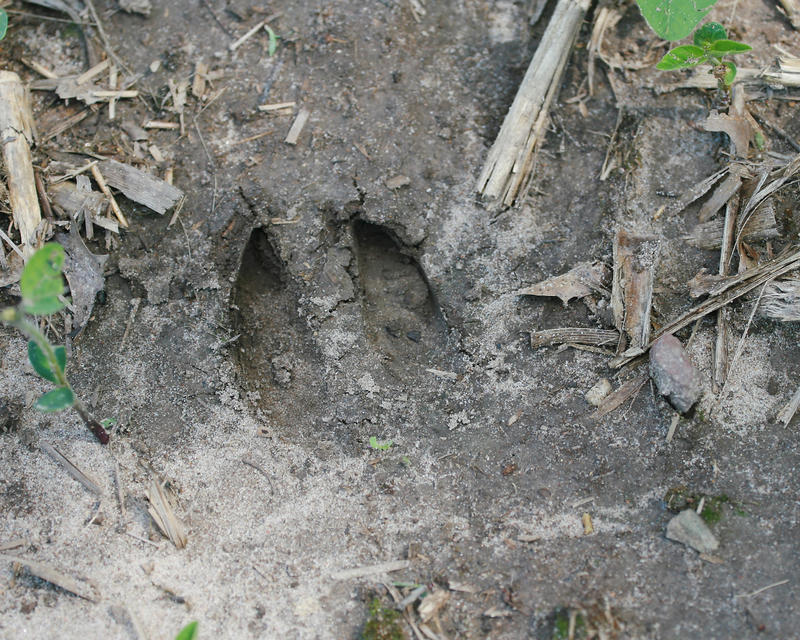
Rubs. Scrapes. Trails. Beds. These typical pieces of sign left behind by deer often get the lions share of attention from hunters and hunting writers. But oftentimes one of the most important clues left by deer are ignored. Tracks. If you learn to look at deer tracks through a careful eye, you’ll be amazed at what you can learn and how it can help you kill deer. With that in mind, lets explore the basics of understanding deer tracks and see how you can apply it to your upcoming deer hunting season.
First off, it’s important to know that small bucks and large does can be hard to tell apart and identify. But once a buck gets to “slob” status, a buck track is easily identifiable. These are the ones we want to pay attention to when trying to identify and learn from tracks. These big buck tracks are unique because the weight of bucks over the 200 pound mark will cause the hooves to splay apart on the front feet. I often use my closed fingers to measure a track. Thus a “4 finger” track is generally a buck that will dress over 200 pounds. It’s important to look at the big picture though. Look at a series of tracks and make certain the splayed tracks are of a walking buck, not running. All running deer will have splayed front hooves. Another trick is to look at the stride of a walking deer and see how far apart his steps are.
I think tracking is way over looked by modern hunters. Hunters living in today’s fast paced society worry too much about getting from point A, to point B. Most hunters need to slow down and notice the signs the deer are leaving behind for us.
That said, I use tracks to tell me the size of the bucks in the area, what individual bucks have been hanging around and how many different big bucks are using the same area.
If I shine or see a certain buck in a field, I go back and check his tracks in a lot of cases. You will find that mature bucks have tracks as unique as their antlers if you train your eye to look close. Some tracks will be very short but wide, others will be long and skinny, some bucks will have a chip or two missing in their hoof leaving a very recognizable impression. You will also notice the very tips of the track will hook in different directions. This can be very useful in keeping track of individual bucks.
You can also look at the direction of the track, some bucks feet will aim outward, some inward, some straight ahead. I should also mention that the left and right hoof will often not match each other, so its important to study both. It’s important to note that I only study deer tracks in areas where I will not be hanging a stand, as I of course don’t want to contaminate actual stand locations with scent.
A lot of the time, after shooting a nice buck, I will return to the area and check the crop fields to see if his fresh track is there or gone. In winter after the season, I also like to go to my hunting areas and find the tracks of the bucks I was hunting and follow them in the snow to learn how each buck travels the ground I hunt and where he beds.
Another valuable tool to learn is how to age a track. It can be very difficult to do sometimes, but it can have great rewards. Say you see tracks in the morning that appear to only be a few hours old leading into a known buck bedding area? I know where I would be setting up that evening.
When you go out to the muddy fields to study tracks, look really close. Look at the definition of the tracks edge. Is the mud cut sharply? Or has weather and time began to round the corners? Look for detail, like the fine lines around the edge of the pad, can you see them? Have they faded with time? Look at the small mud balls and broken pieces of dirt, that have broken free from the large foot cutting the soil. Are they still moist? Are they sun dried? Are they cemented back to the soil?
How can you tell between a buck’s front tracks and his hind tracks? Front tracks are noticeably larger. Front tracks also sink in deeper and splay more due to the heavier front end on a mature buck.
You will get the idea after you study some tracks, so I would suggest visiting some fields a day or two after we get a good rain, and study what you see. I would also suggest you find a fresh track in the muddy field and take a close up clear digital photo of it. Return every day for a week and take another photo daily. Compare the photo’s.
How can you tell the difference between a running or walking track? It can be hard to tell if a single track is a running or a walking track. If the track is indeed a running track, there should be some subtle signs you can pick up on. Does the track have debris thrown in front of it from a running hoof impacting the ground? Does the track look as if it slid forward adding to the length and splay?
Often, if a running track is fresh or only a couple days old, you can see the running tracks even on ground covered with vegetation or hard surfaces. A 200 pound buck running through the forest leaves a mark. Many times I have tracked large bucks after they are shot, with little or no blood trail, just by following the disturbed leaves on the ground.
Wouldn’t there be a “ridge” of dirt between the hooves where it first makes contact with the ground and then spreads apart as weight is applied? In a lot of cases yes. But some older deer tend to develop feet that seemed to be stretched to a permanent splay over time from the weight being on the feet for several years.
In moist or wet soil, alot of the time these permanently splayed bucks will trap large hunks of mud between their hooves that will drop off between footsteps. We like to call these hunks of mud “wedgies”. The wedgies take on a unique shape. Keep an eye out for this.
How can you tell the difference between a doe and buck track? To tell the difference between a buck and a doe track:
A buck has a large chest and narrow rear. A doe has a narrow chest and slightly larger rear in comparison.
A buck’s rear track should fall slightly to the inside of the front tracks. The rear track gap from left to right foot should be narrower than front track gap.
A does casual rear track should be slightly outside of the front tracks. So the rear track gap from left to right foot should be wider than the front track gap. Younger deer in general tend to step with their hind feet into there front track.

Let’s take a look at a few other tracks, and I’ll point out some key characteristics I like to take note of.

In the picture above, if you look close you will notice a lot of displaced soil from where the deer pushed his foot into that spot. The chunks of soil still show good signs of their original shape and have not “weathered down.” The soil highest up from the impression has dried, telling me the track is at least 1/2 a day old, and the lower chunks and the track itself are still moist, telling me its not much more than a day old. The mud chunks do not look to have attached themselves to the ground yet either. You can check that by touching the chunks with your finger or a small stick. After a couple days, the chunks will stick to the soil underneath. You should also notice the defined cuts in the soil and shape of the center wedge, another indicatior of a semi-fresh track.
My best guess would be, this track was photographed in the late morning and made sometime in the evening or early in the night before the dew occurred.
Now that we have an idea of when the track was made, we would want to identify the track in case we notice more big tracks. We would be interested in knowing if more than one big slob lives in the area, where the buck or bucks are hanging, and what food sources they are preferring, etc. To keep track of this, I would want to see both tracks and either take a good digital pic, or just use my memory if neccesary. The first characteristic that catches my eye is, the track appears “square” the actual hoof impression looks to measure close to 3 inches square, not including the dew claw impressions.
I also notice the two sides each point outward and straight ahead. I also always look at the tip very closely, they often hook one way or the other and don’t always match side to side, or hoof to hoof. This dude appears to have no hooking on the tips on either side and the tips are pointing forward and slightly outward.

This is another unique track. At first glance, most hunters would call it a running track, but if you look close the edges are sharply cut, there is no sliding of the hoof, and no debris thrown forward of the track. This is a walking track.

Short, right toe, with right side tip hooking inward.

Running track with obvious debris scattered forward of the track, although the track appears fresh, the sides are busted from the deer hoof impacting the ground and flinging forward.

When I get scouting camera photos from good bucks, I will look at their tracks and try to memorize the image and subtle differences of his impressions, so I will know if I run across the track again. Another way to keep track is to cast the track in plaster and keep it to review.
As important as the popular whitetail sign posts such as rubs and scrapes are, it’s equally important to not forget about tracks. Learn to recognize and age tracks, and it will help you target and kill mature bucks for many years to come.








Conversation